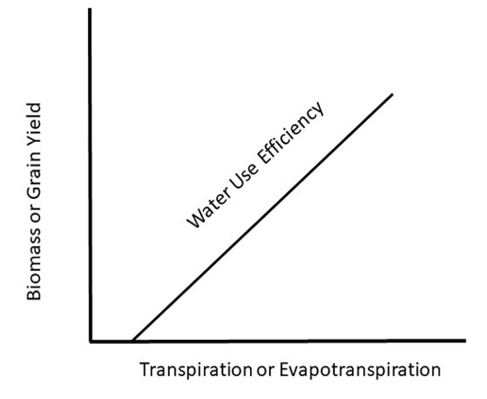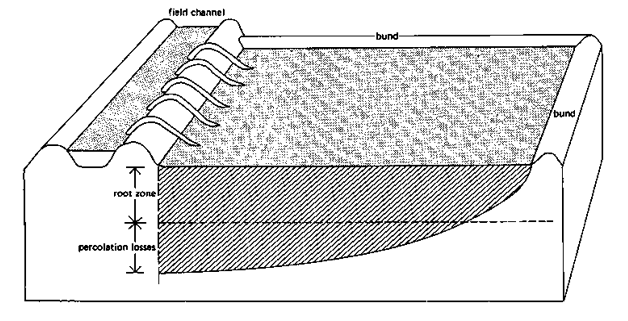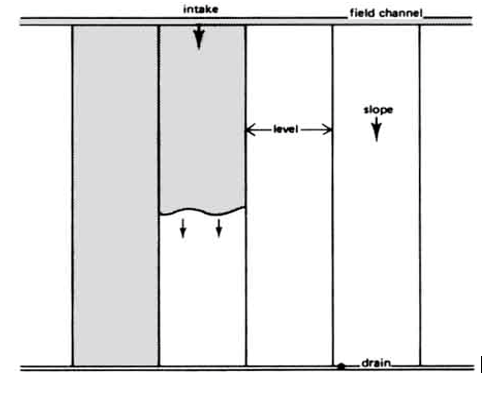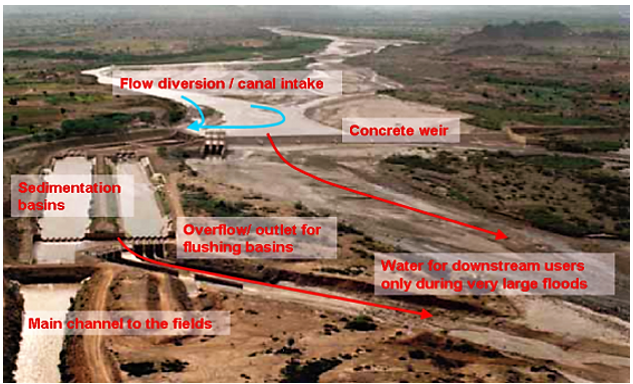Flood irrigation systems and Water Use Efficiency

This post is also available in:
This post is also available in:
![]() Español (Spanish)
Español (Spanish)
Despite the importance of Water Use Efficiency (WUE) in crop production and resilience, few African farmers, subsistence or commercial, think much about it. Their main concern, especially in cases where water is seen to be abundantly available, is to provide irrigation to meet the requirements of the crop regardless of how much water is being used. A misconceived notion that water is an abundant, near-unlimited resource is what drives this poor agronomic practice. This can lead to long-term negative effects on the environment and a reduction in water availability for other users.
WUE can be defined as the ratio of water used in a plant’s metabolism divided by the amount of water lost by the plant through transpiration. Alternatively, WUE is the yield produced per unit of water used by the plant. There are mainly two categories of WUE:
- Photosynthetic/ instantaneous water use efficiency which refers to the amount of carbon assimilation to the rate of transpiration.
- Water use efficiency of productivity, which is the ratio of biomass produced to the rate of transpiration. In this article, we will elaborate on the second category.

Fig 1: A simple graphical illustration of WUE (Source: frontiersin.org)
We will present examples of where this problem is, its effects, how to mitigate this challenge, and possible cost-effective alternatives.
Flood Irrigation, or Surface Irrigation, is the main form of irrigation most small-scale farmers use. It is often viewed as the fastest and cheapest form of irrigation. Many who have visited or lived in Africa’s higher rainfall, floodplain, and delta regions would be familiar with this practice. In desert oasis spots, this form of irrigation is also a common practice in some cases. Crops such as rice, vegetables, and sugar cane are typical examples of what are often grown using this method. One of the greatest challenges with flood irrigation is water wastage due to runoff. As with other irrigation systems, there is a risk of increased soil salinity and the spread of chemicals (e.g., pesticides) and nitrates (fertilizer) downstream, polluting rivers. At the same time, this water overuse leads to water scarcity from other native flora and fauna that have lived in these habitats for generations.
Under Flood irrigation, we have three main types:
I. Level Basin – basically is the flooding of an entire area. In most cases, a level area of land is flooded, and then the water is allowed to infiltrate. It is a method preferred for lands with predominantly clay soils or low infiltration rates. This is shown below in Fig 2.

Fig 2. Level Basin Flooding (Source: FAO.org)
II. Furrow – this is typically the channeling of water through furrows and canals downstream or following a slope adjacent to raised beds of crops where the water is required. The supply rate depends on the steepness of the slope and the crop type (hence the significance of the plant’s evapotranspiration factor with crops such as tomatoes requiring more water than others such as okra). The physical properties of the soil will also affect the infiltration rate while the water is running in the furrow. Surge irrigation, a relatively new practice, is often regarded as a component of furrow irrigation. It involves pulsating water flow on and off; these wetting and drying cycles result in soil surface sealing, reducing the infiltration rate in the furrow. As a result, this type of irrigation is more cost-effective in soils that are not predominantly clay.

Fig 3. Furrow Irrigation (Source: FAO.org)
III. Border Strip – can be viewed as a combination of Furrow and Level Basin irrigation; it involves using raised earth strips (raised beds) above a level area. These strips are narrower and longer than in the case of Level Basin irrigation. This irrigation method is also often used in fields grown for pasture in dairy production.

Fig 4. Border Strip Irrigation (Source: FAO.org)
In addition to the above, Spate Irrigation can be viewed as a form of water harvesting for immediate irrigation that is mainly used in arid and semi-arid regions such as the Sahel, Horn of Africa, and throughout the populated areas of the Sahara. It is channeling water from dry rivers, streams, lakes, or ponds once there is early flooding, often at the onset of the rainy season, and diverting that water to crop fields.
 Fig 5. Spate Irrigation (Source: SSWM.info)
Fig 5. Spate Irrigation (Source: SSWM.info)
The above are typically the primary forms of irrigation used in Africa by small-scale farmers. However, other irrigation systems/methods often used by the more affluent commercial and emerging farmers are typically designed to be more water-use efficient: drip, micro jet, rain gun/ high pressured sprinkler water jet irrigation, lateral pipe, and center pivot irrigation.
These are more expensive to set up and often, as is the case with center pivot irrigation, require costly high-voltage electricity supply installation.
Furthermore, regarding center pivot irrigation (the commercial farmer’s preferred irrigation system for growing cereal crops), it is often assumed that runoff losses are greatly reduced compared to flood irrigation. The reality, however, is center pivot irrigation, just like flood irrigation, can lead to soil erosion within and on the edges of fields. The problem is greater in fields with stip slopes. The high runoff can lead to the formation of deep gulleys over time (even with the use of preventative landscaping practices such as erecting contours), and this often leads to the washing away of fertile top soils, resulting in the higher elevated areas of the fields containing less clay, organic matter and more gravel in the top horizons of the soil profile than the lower (downslope) side of the fields. Therefore, it is not environmentally and economically sound in the long term to use center pivot irrigation on vast land areas with high slope variations. Other key factors, such as the flow rate of water and soil physical properties, must also be considered. This topographic, hydrologic, and soil analysis assessment is not always taken into serious consideration, and commercial farmers, even in hilly areas, due to land scarcity of fertile soils and close proximity to water sources, go ahead to set up several center pivot irrigation systems with full knowledge of what the environmental risks are to doing this in an area with unsuitable topography. Some of the center pivot irrigation systems can be as long as 8 to 10 spans/ towers, which typically will cover 65 to 100 hectares each; that is a significant amount of land at risk of being eroded due to high runoff.
References
Alenaheyu T. (2010) Spate Irrigation in Ethiopia, Potential, Development, Status and Challenges, http://www.iwmi.cgiar.org/Publications/Other/PDF/proceeding-flood-based_farming_for_food_security_and_adaptation_to_climate_change_in_Ethiopia-potential_and_challenges-chapter-1.pdf
Andulaem T. G and Mulatu K. (2020) Review of Irrigation Practices in Ethiopia, Lessons from Israel, https://www.eng.uc.edu/~beaucag/DripIrrigation/Papers/review-of-irrigation-practice-in-ethiopia-lessons-from-israel.pdf
Hatfield L. Jerry (2019) Water Use Efficiency: Advances and Challenges in a Changing Climate, https://www.frontiersin.org/articles/10.3389/fpls.2019.00103
Zwedie, H. S. (2022) Wheat Policy Yield and Production in Ethiopia, https://www.tandfonline.com/doi/full/10.1080/23322039.2022.2079586









































































